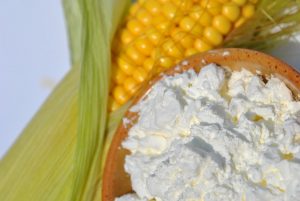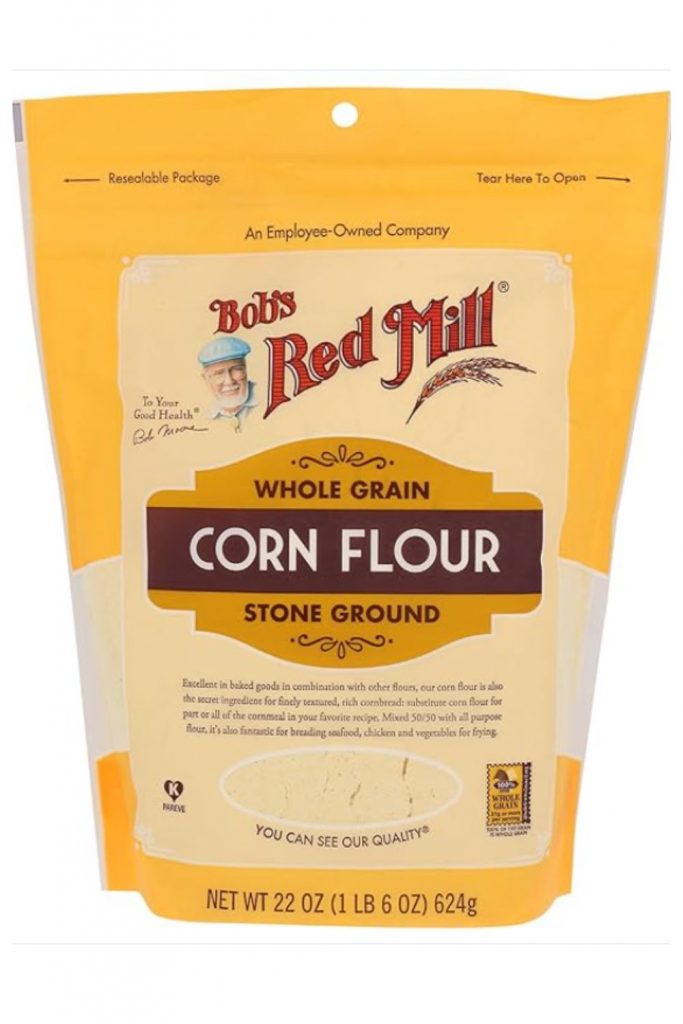What are the best substitutes for Corn Flour?
Are you looking for a corn flour substitute? In this article, we will explore the top 10 cornflour alternatives that will perfectly suit your dietary preferences and recipes. Whether you’re following a gluten-free diet, avoiding corn-based products, or simply experimenting with new ingredients, these alternatives will add a unique twist to your culinary creations.
So, for a corn flour substitute we suggest you try using: Cornstarch, Arrowroot Powder, Tapioca Starch, Potato Starch, Rice Flour, Almond Flour, Coconut Flour, Chickpea Flour, Tapioca Flour, or Masa Harina.
What is Corn Flour?
Cornflour is a fine powder made from corn, specifically from the endosperm (the part of a seed which acts as a food store for the developing plant embryo,) of the corn kernel. The process involves separating the starch from the corn and then refining it into the powdery substance we all know and love. A versatile ingredient you can easily use it in cooking and baking. Cornflour is great for thickening sauces, soups, and gravies. You should also be aware that corn flour does not contain gluten which makes some bread crumble and dense. This makes it a fantastic ingredient for gluten-free recipes.
Okay, before we look at your cornflour substitute options, let’s deal with that empty cupboard situation!
Where can I buy Corn Flour?
If you want to be more prepared and ensure you don’t run out of cornflour, then you should stock up now.
Nowadays, most delicatessens and general supermarkets stock a wide variety of cornflour. Or if you prefer you can also purchase cornflour on-line.
So why not jump on and place your order today.
STOCK UP NOW!
Excellent quality product. Great flavor and texture. Made from whole-grain corn.
Perfect for gluten-free baking. And suitable for Kosher diet.
What can I substitute for Corn Flour?
Here are some of the best ingredients to substitute the flavor and role that cornflour provides in your recipes.
Cornflour substitutes
- Cornstarch
- Arrowroot Powder
- Tapioca Starch
- Potato Starch
- Rice Flour
- Almond Flour
- Coconut Flour
- Chickpea Flour
- Masa Harina
- General-purpose Flour
Cornstarch
Ah, the cornflour vs. cornstarch conundrum! In many places, these terms are used interchangeably, but there can be some differences depending on where you are.
In the U.S. and Canada, “cornstarch” is the term commonly used for the powdery stuff derived from corn. It’s a fine, white powder that’s primarily used as a thickening agent in cooking and baking. Whereas cornflour has a slight yellow tinge to it.
Now, in the U.K., Australia, and some other regions, “cornflour” refers to what Americans and Canadians call “cornstarch.” It’s actually the same thing – a starchy powder used for thickening sauces and such.
To add a bit more confusion, in the U.S., “corn flour” usually refers to finely ground cornmeal, which is different from cornstarch.
So, if you’re reading a recipe, make sure to pay attention to where it’s from to get the right ingredient. But for most practical purposes, when it comes to thickening, you can usually use cornflour and cornstarch interchangeably.
Did you know that cornstarch is gluten-free! It’s made from the starchy part of corn, not wheat or any gluten-containing grain. So, if you’re into gluten-free cooking or need alternatives for thickening sauces and gravies, cornstarch is a safe bet. It’s a versatile ingredient that can be a go-to for folks with gluten sensitivities or those simply exploring gluten-free options in their recipes.
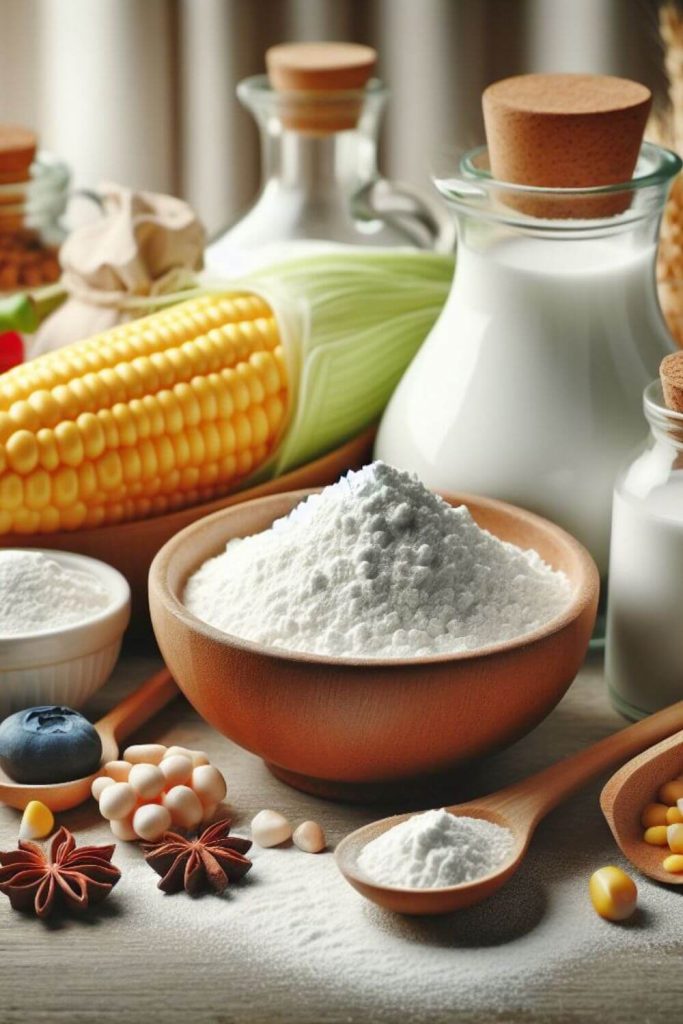
Arrowroot Powder
Arrowroot is a starchy substance which you extract from the roots of certain tropical plants. It’s a fantastic alternative to cornflour, especially if you’re looking for a gluten-free option. Here’s how you can use arrowroot as a substitute for cornflour in your recipes:
- Thickening Agent: Arrowroot works well as a thickening agent in sauces, soups, and gravies. To use it, mix a small amount of arrowroot with a cold liquid (water or broth) to form a smooth paste before adding it to your hot dish. This helps prevent lumps.
- Baking: You can use arrowroot just as you would use cornflour in baking. It gives a light and airy texture to baked goods. When using it in baking, you can typically substitute it in a 1:1 ratio for cornflour.
- Fruit Pies and Desserts: Arrowroot is excellent for fruit pies and desserts. It creates a clear, glossy finish without clouding the filling.
- Dairy-based Dishes: It’s also suitable for dairy-based dishes, as it doesn’t break down in acidic ingredients.
Remember, arrowroot is more heat-sensitive than cornflour, so it’s best to add it toward the end of your cooking or baking process. And as always, feel free to adjust the quantities based on your taste and desired consistency.

Tapioca Starch/Flour
Tapioca starch, also known as tapioca flour, is a fine, powdery substance extracted from the roots of the cassava plant. It’s a gluten-free alternative to cornflour with its own unique properties. Here’s how you can use tapioca starch as a substitute for cornflour:
- Thickening Agent: Tapioca starch is an excellent thickener for soups, sauces, and gravies. To use it, mix it with a bit of cold liquid to create a slurry before adding it to your hot mixture. This helps prevent clumping.
- Baking: Tapioca starch works well in gluten-free baking, providing a light and chewy texture to baked goods. You can use it on a 1:1 substitute in place of cornflour in most recipes.
- Puddings and Desserts: Tapioca starch is commonly used in puddings and desserts to achieve a smooth and silky texture. It’s particularly great in fruit pies and custards.
- Binding Agent: Tapioca starch can act as a binder in recipes, similar to cornflour. It helps hold ingredients together, making it useful in dishes like veggie burgers or meat substitutes.
- Coating for Frying: In some recipes, tapioca starch can be used as a coating for frying to achieve a crispy texture. It’s a gluten-free alternative to traditional flour for this purpose.
Remember to adjust the quantity based on your specific recipe and desired consistency. Tapioca starch can add a unique texture to your dishes, so feel free to experiment.
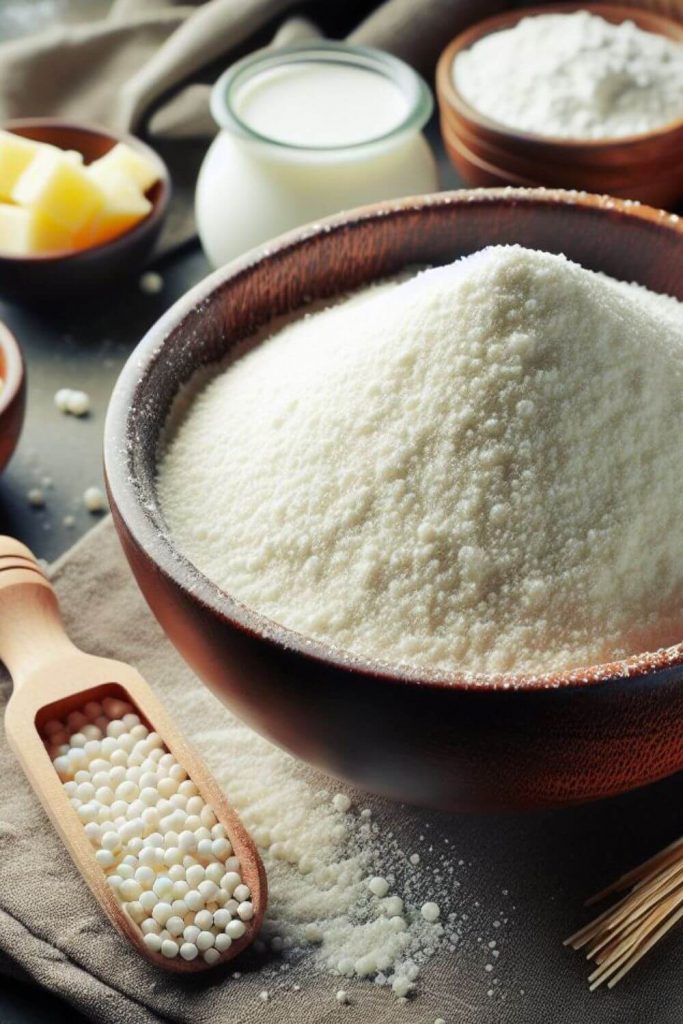
Potato Starch as a Corn Flour substitute
Potato starch, also known as potato flour, is a fine powder made from the starch extracted from potatoes. It’s a versatile ingredient with various culinary applications. Here’s how you can use potato starch as an alternative to cornflour:
- Thickening Agent: Like cornflour, potato starch is an excellent thickening agent for soups, stews, sauces, and gravies. Mix it with a cold liquid (water or broth) before adding it to your hot dish to avoid lumps.
- Baking: Potato starch is perrect for use in gluten-free baking. It can be a 1:1 substitute for cornflour in many recipes, providing a light and fluffy texture. However, keep in mind that potato starch tends to absorb more liquid, so you may need to adjust the quantities accordingly.
- Coating for Frying: Just like cornflour, potato starch works well as a coating for frying. It creates a crispy exterior, making it an excellent choice for fried chicken, vegetables, or other fried delights.
- Dairy-based Dishes: Potato starch is stable in dairy-based dishes and doesn’t break down in acidic environments. It’s suitable for use in creamy sauces and desserts.
- Gluten-Free Flour Blend: You can include potato starch as part of a gluten-free flour blend for various recipes, including pancakes, waffles, and cakes.
When substituting potato starch for cornflour, consider the specific requirements of your recipe and the desired consistency.
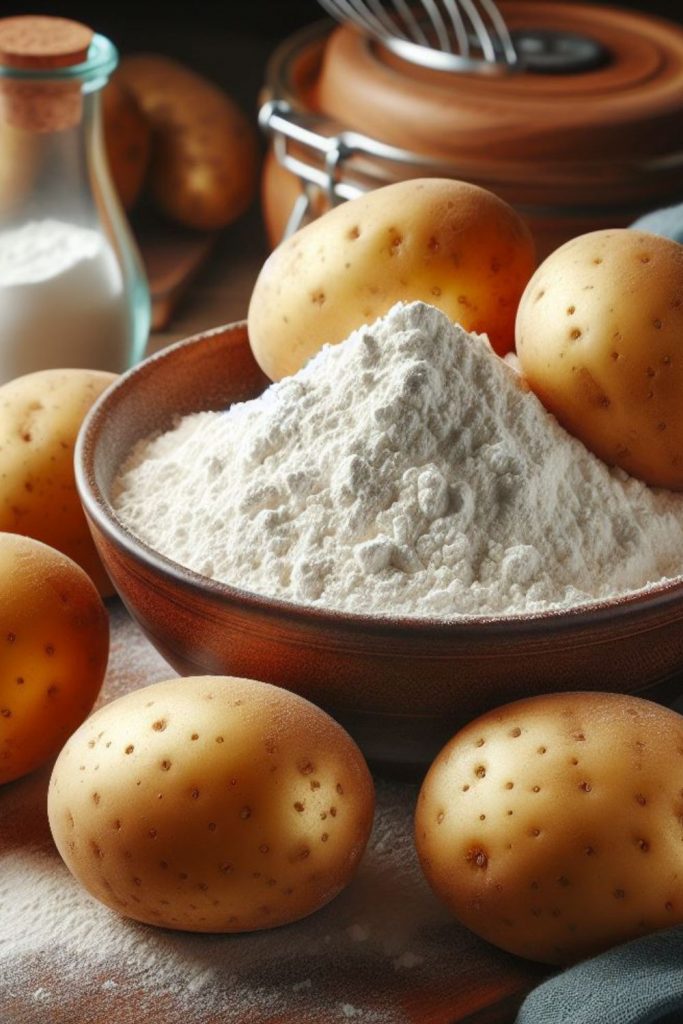
Rice Flour as a Corn Flour substitute
Rice flour is a type of flour made from ground rice grains. It comes in various forms, such as white rice flour, brown rice flour, and sweet rice flour (also known as glutinous rice flour, despite being gluten-free). Here’s how you can use rice flour as an alternative to cornflour:
- Thickening Agent: Rice flour works well as a thickening agent in sauces, soups, and gravies. Similar to cornflour, you can create a slurry by mixing rice flour with a cold liquid before adding it to your hot dish.
- Baking: Rice flour is a fantastic gluten-free option for baking. You can use it as a 1:1 substitute for cornflour in many recipes. Experiment with it in cakes, cookies, and other baked goods to achieve a delicate texture.
- Coating for Frying: Rice flour is an excellent choice for creating a crispy coating for fried foods. Whether you’re frying vegetables, chicken, or fish, rice flour can provide a satisfying crunch.
- Asian Cuisine: Rice flour is a staple in many Asian cuisines. You can use it in recipes like rice noodles, dumplings, and various desserts. Explore traditional dishes from different cultures to incorporate rice flour in diverse ways.
- Gluten-Free Flour Blend: If you’re working on gluten-free recipes, consider using rice flour as part of a gluten-free flour blend. Mixing it with other gluten-free flours can provide a well-rounded texture.
Keep in mind that different types of rice flour may have slightly different properties, so you can choose the one that best suits your recipe. Whether you’re thickening, baking, or frying, rice flour can be a versatile addition to your alternative ingredients.
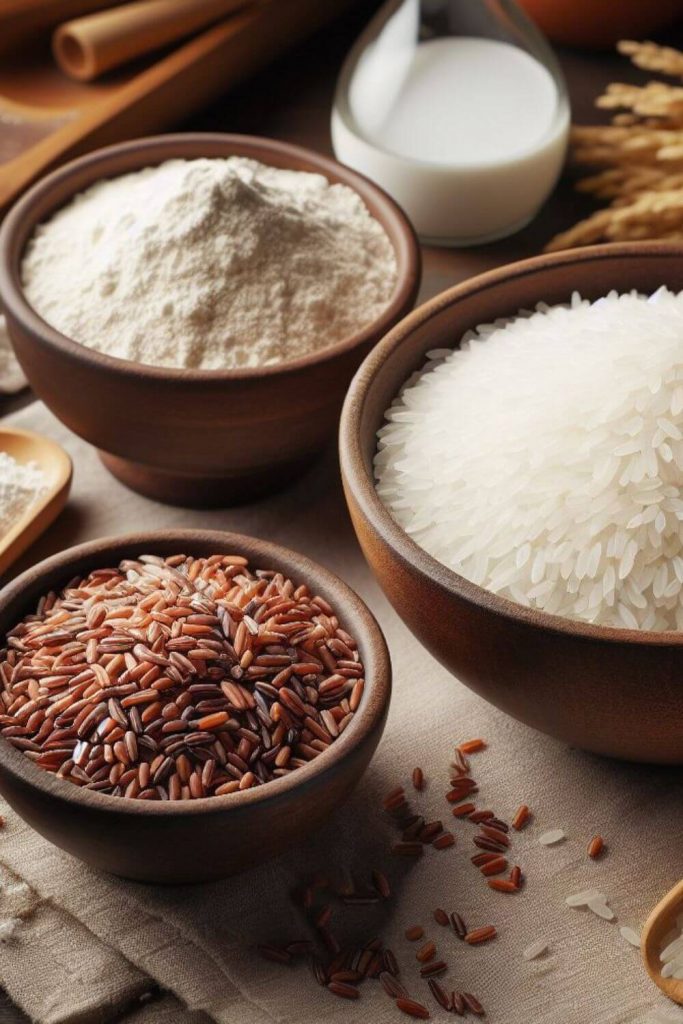
Almond Flour as a Corn Flour substitute
Almond flour is a gluten-free flour made from finely ground blanched almonds. It’s a popular alternative to traditional flours for those following a gluten-free or low-carb diet. Here’s how you can use almond flour as an alternative to cornflour:
- Baking: Almond flour is fantastic for baking, especially in gluten-free recipes. It adds a rich, nutty flavor and a moist texture to your baked goods. When substituting for cornflour, keep in mind that almond flour is denser, so you may need to adjust the quantities and possibly combine it with other gluten-free flours for the desired texture.
- Coating for Frying: Almond flour works well as a coating for frying, providing a crispy outer layer. It’s a great option for pan-frying or baking for a healthier twist on fried foods.
- Thickening Agent: While almond flour is not as effective as cornflour in thickening liquids, you can still use it in certain recipes where a slightly nutty flavor won’t overpower the dish. Consider making a slurry with almond flour and cold liquid before incorporating it into your hot mixture.
- Breading for Meat or Vegetables: Use almond flour as a gluten-free alternative for breading meats or vegetables. It adds a unique flavor and a pleasant crunch to your dishes.
- Snack Bars and Cookies: Almond flour is a star ingredient in gluten-free snack bars and cookies. It contributes to a chewy and moist texture while bringing a delightful almond flavor to your treats.
Experimenting with almond flour in your recipes can add a tasty and nutritious element to you food. Just be mindful of its unique characteristics and adjust accordingly for the best results.
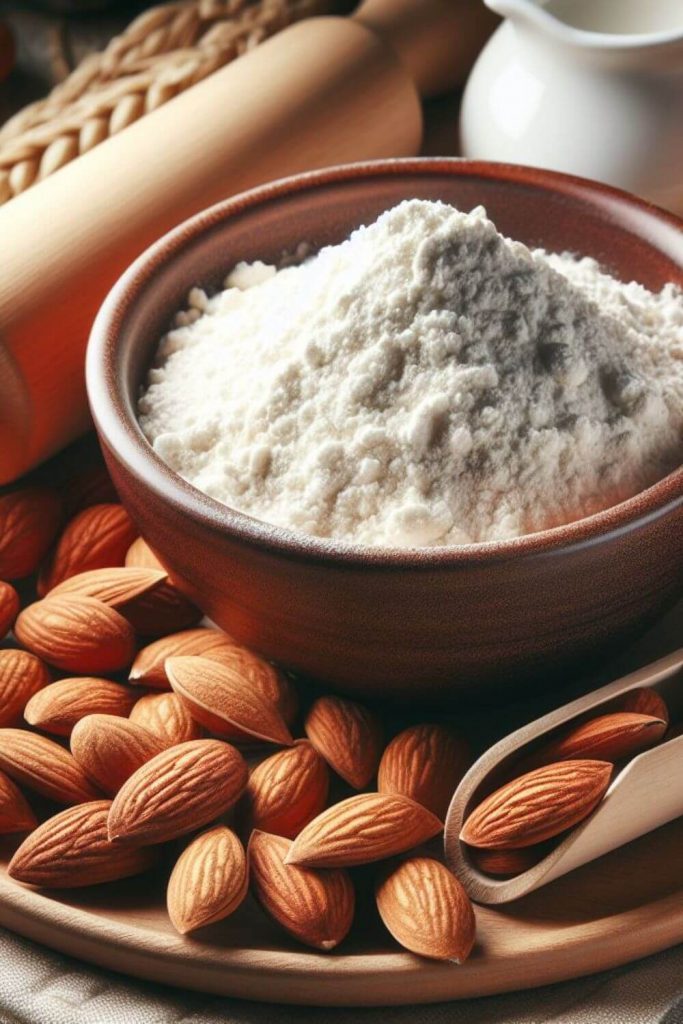
Coconut Flour as a Corn Flour substitute
Coconut flour is a gluten-free flour made from dried coconut meat after the oil has been extracted. It’s a flavorful and high-fiber alternative to traditional flours. Here’s how you can use coconut flour as an alternative to cornflour:
- Baking: Coconut flour is commonly used in gluten-free and paleo baking. It’s highly absorbent, so you’ll need less of it compared to other flours. When substituting for cornflour, start with a smaller quantity and increase if necessary. It adds a subtle coconut flavor and a moist texture to baked goods.
- Thickening Agent: While coconut flour isn’t as effective as cornflour in thickening liquids, you can use it in certain recipes. It’s best to mix coconut flour with a cold liquid to create a slurry before incorporating it into hot mixtures to prevent clumping.
- Breading for Frying: Coconut flour works well as a coating for frying, providing a unique tropical flavor. It’s particularly suitable for chicken, shrimp, or vegetables. The coconut aroma can enhance the overall taste of your dish.
- Gluten-Free Pancakes and Waffles: Coconut flour is a fantastic addition to gluten-free pancake and waffle recipes. It helps achieve a light and fluffy texture while infusing a subtle coconut essence.
- Energy Bites and Bars: Coconut flour is a nutritious choice for energy bites and bars. Its high fiber content adds a satisfying and wholesome element to your snacks.
Keep in mind that coconut flour has distinct properties, including its high absorbency, so it may require some experimentation to get the right balance in your recipes.
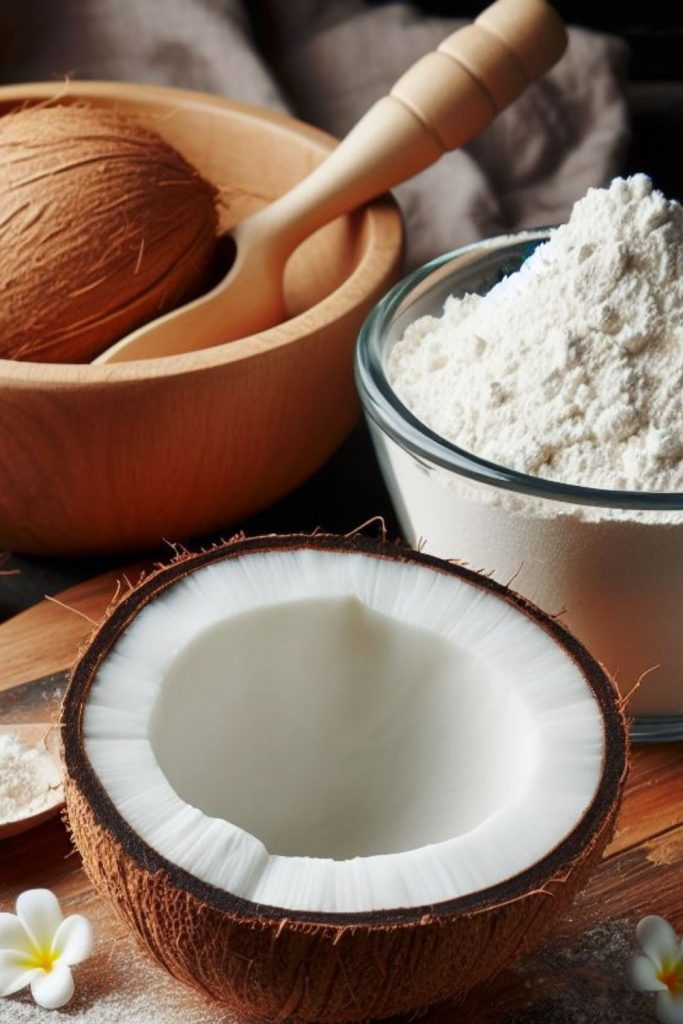
Chickpea Flour as a Corn Flour substitute
Chickpea flour, also known as gram flour or besan, is made from ground dried chickpeas. It’s a versatile gluten-free flour with a nutty flavor and a slightly dense texture. Here’s how you can use chickpea flour as an alternative to cornflour:
- Baking: You can use chickpea flour in gluten-free baking, especially in recipes like flatbreads, pancakes, and savory muffins. It adds a distinctive taste and can contribute to a dense and hearty texture. When substituting for cornflour, consider the specific requirements of your recipe and adjust accordingly.
- Thickening Agent: While chickpea flour is not as neutral in flavor as cornflour, it can still be used as a thickening agent in certain dishes. Mix it with cold liquid to create a smooth paste before adding it to hot mixtures to prevent lumps.
- Batter for Frying: Chickpea flour makes an excellent batter for frying. It creates a crispy coating for vegetables, fritters, and even proteins. The nutty flavor can add a delightful dimension to your fried dishes.
- Savory Dishes: Chickpea flour shines in savory dishes like socca (a type of flatbread), pakoras, and savory crepes. Its distinctive taste complements spices well, making it a staple in many cuisines.
- Gluten-Free Roux: Use chickpea flour to make a gluten-free roux, which is a mixture of fat and flour used to thicken sauces and gravies. It may have a slightly different taste than traditional roux, but it works well in gluten-free and vegetarian recipes.
Remember to adjust the quantities based on your taste preferences and the specific requirements of your recipes. Chickpea flour brings a unique flavor and nutritional profile to your dishes, making it a great addition to your alternative ingredient lineup. And if you run out of chickpea flour here are some substitutes to get you through.
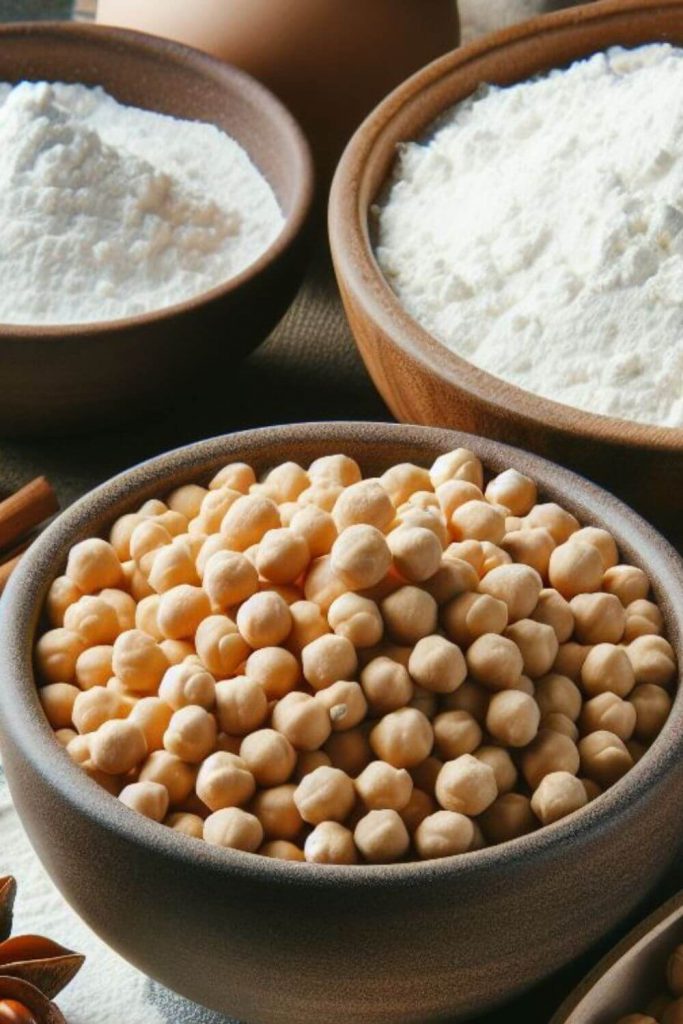
Masa Harina as a Corn Flour substitute
Masa harina is a type of flour made from dried and ground hominy, which is corn that has been treated with an alkali, usually lime. It’s a key ingredient in traditional Mexican and Central American cuisine, especially for making tortillas and tamales. Here’s how you can use masa harina as an alternative to cornflour:
- Tortillas: Masa harina is the primary ingredient for making corn tortillas. Simply mix masa harina with water and a pinch of salt to form a dough. Press the dough into thin rounds and cook them on a hot griddle. You can use a tortilla press for uniform results.
- Tamales: Masa harina is a key component in tamale dough. Mix it with broth or water, lard or shortening, and seasonings to create a dough that can be spread on corn husks, filled, and then steamed.
- Pupusas: This Salvadoran dish involves stuffed corn tortillas. Make the dough with masa harina and water, and then fill with ingredients like cheese, beans, or meat before cooking on a griddle.
- Arepa: Masa harina can be used to make arepas, a type of flatbread popular in South America. The dough is formed into rounds, cooked, and then sliced open to create a pocket for various fillings.
- Empanadas: Use Masa harina to make the dough for empanadas, providing a delicious corn flavor to the pastry. Fill the empanadas with your choice of sweet or savory fillings.
When using masa harina as an alternative to cornflour, keep in mind that it has a distinct flavor and texture due to the nixtamalization process. While it may not be a direct substitute in all recipes, it brings its unique characteristics to traditional dishes.
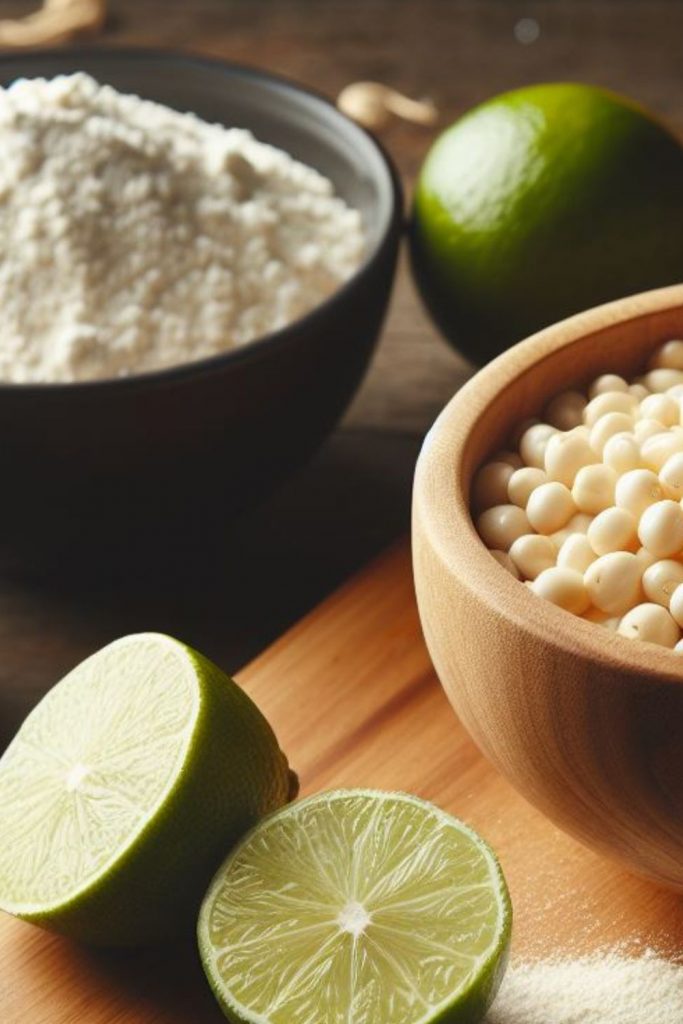
General-purpose Flour
General-purpose flour, often referred to as all-purpose flour, is a versatile type of flour that is a blend of hard and soft wheat varieties. It’s commonly used in a wide range of recipes and is suitable for both baking and cooking. Here’s how you can use general-purpose flour as an alternative to cornflour:
- Baking: All-purpose flour is a standard choice for baking, and it can be used in a variety of recipes like cakes, cookies, bread, and more. When substituting for cornflour, keep in mind that all-purpose flour contains gluten, so the texture of your baked goods may differ slightly.
- Thickening Agent: All-purpose flour is a great thickening agent for sauces, gravies, and soups. To use it as a substitute for cornflour, create a roux by combining equal parts flour and fat (like butter or oil), then gradually whisk it into your hot liquid for a smooth texture.
- Coating for Frying: Use All-purpose flour as a coating for frying, providing a crispy texture. Use it for frying chicken, vegetables, or other foods. You can add seasonings to the flour for extra flavor.
- Doughs and Batters: All-purpose flour is a staple in making doughs and batters for various dishes. Whether you’re making pizza dough, pancakes, or tempura batter, all-purpose flour is a reliable choice.
- Bechamel Sauce: You use All-purpose flour to make a bechamel sauce, which is a white sauce in dishes like lasagna and macaroni and cheese. It serves as a creamy and thick base.
Remember that all-purpose flour contains gluten, so it might not be suitable for those with gluten sensitivities. Adjust the quantities based on your recipe and desired consistency. While it won’t work for gluten-free recipes, all-purpose flour is a versatile alternative in many cooking and baking applications.
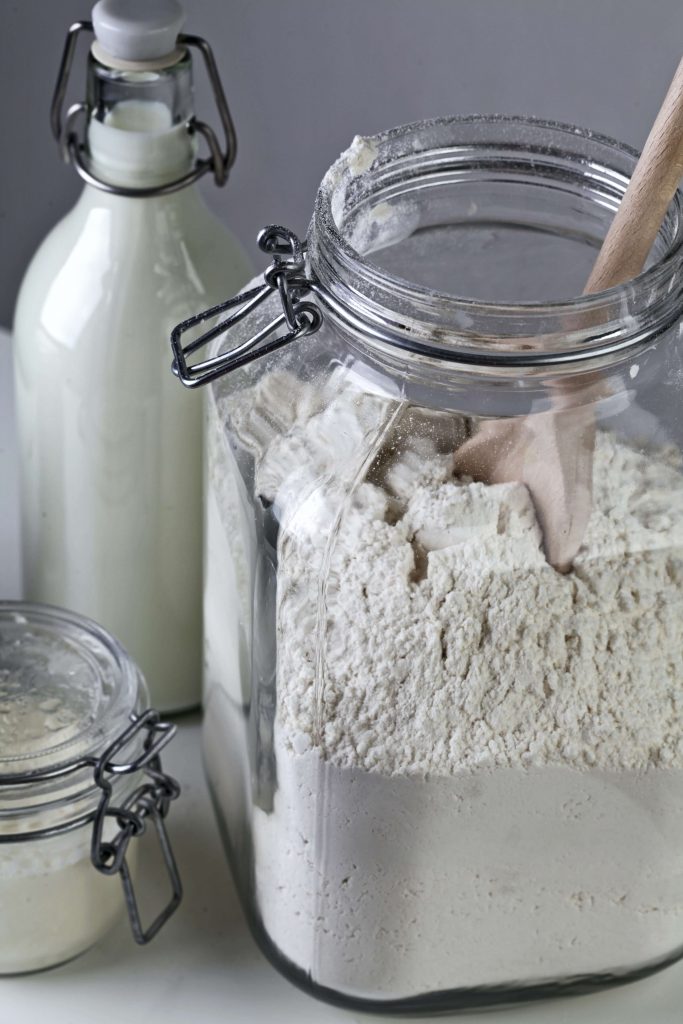
FAQs
How do you thicken sauce without cornflour?
There are several alternatives to cornflour for thickening sauces. One common option is arrowroot powder, which works similarly to cornflour but with a more neutral taste. Another option is tapioca flour or tapioca starch, which is derived from cassava root and can provide a glossy finish to your sauce. You can also try potato starch, which is gluten-free and adds a subtle thickness to sauces. Alternatively, you can use all-purpose flour or rice flour if gluten is not a concern. These alternatives may require slightly different cooking methods or amounts compared to cornflour, so it’s a good idea to experiment a bit to find the best option for your recipe.
Can I use plain flour instead of corn flour in a pavlova?
Sorry, but using plain flour instead of cornflour in a pavlova is not recommended. Cornflour, also known as cornstarch, is often used in pavlova recipes because it helps create the light, delicate texture that pavlovas are known for. Cornflour also aids in absorbing moisture, which helps prevent the pavlova from becoming too sticky or chewy.
If you don’t have cornflour on hand, it’s better to use a suitable alternative like arrowroot powder or tapioca starch. These alternatives can provide similar thickening properties without compromising the texture of your pavlova. Using plain flour may actually result in a denser and less delicate pavlova, which could affect its overall quality.
Summary for Cornflour substitutes
Okay – that’s you all sorted with suitable substitutes for cornflour.
So, when you need a corn flour substitute here’s our top 10 alternatives.
- Cornstarch: Made from the starchy part of corn this is a gluten-free ingredient.
- Arrowroot Powder: Great for thickening and works well in sauces and gravies.
- Tapioca Starch: Offers a similar texture to cornflour, ideal for various recipes.
- Potato Starch: Versatile and neutral in taste, an excellent thickening agent.
- Rice Flour: A gluten-free option that works well in both sweet and savory dishes.
- Almond Flour: Imparts a nutty flavor and perfect for gluten-free baking.
- Coconut Flour: Adds a hint of coconut flavor and is gluten-free.
- Chickpea Flour: Packed with protein, great for a nutritional boost in recipes.
- Masa Harina: Masa harina is the primary ingredient for making corn tortillas.
- General-purpose flour: Perfect for achieving the desired texture in different dishes.
We have gathered together a lot more facts on ingredients such as herbs, spices, oils, nuts, etc. if you would like to learn some more.
Or if you need to swap out another ingredient have a look at our Substitutes section.
Table of Contents
- What are the best substitutes for Corn Flour?
- What is Corn Flour?
- Where can I buy Corn Flour?
- What can I substitute for Corn Flour?
- Cornflour substitutes
- Cornstarch
- Arrowroot Powder
- Tapioca Starch/Flour
- Potato Starch as a Corn Flour substitute
- Rice Flour as a Corn Flour substitute
- Almond Flour as a Corn Flour substitute
- Coconut Flour as a Corn Flour substitute
- Chickpea Flour as a Corn Flour substitute
- Masa Harina as a Corn Flour substitute
- General-purpose Flour
- FAQs
- Summary for Cornflour substitutes
